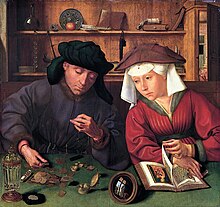Commercial revolution
Appearance

Commercial revolution is a term that is mainly used in the context of the development of the economy in Europe, from the Middle Ages to the Renaissance. During this time, new forms of commerce developed, such as banks, stock exchanges or limited partnerships. The first to use the term was Raymond de Roover, in the 1942. Karl Polanyi also used the term, shortly afterwards. In 1955, Roberto Sabatino Lopez used the term to contrast it with the Industrial Revolution.
During the commercial revolution there were some changes:
- The promissory note was introduced. At the very start, this was a note that the issuer of the note would pay a given amount of money, at a specified place and time. These notes were tradeable. It was a precursor of the cheque, introduced later.
- Introduction of bookkeeping
- Specialization of a mostly agrarian society. Certain regions were specialized, such as getting cloth from Flanders. This also saw the growth of cities and the establishment of a wealthy middle class. There were guilds in the cities who kept records, of who did what. This is a precursor of the modern register of commerce.
- The law saw a specialization, and special trade laws were introduced.
